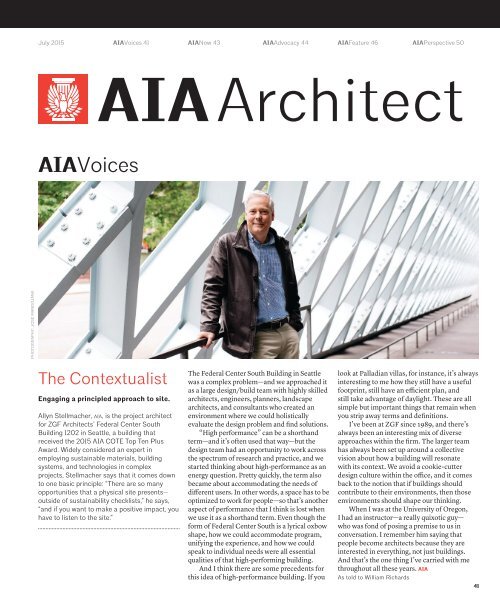Architect 2015-07
You also want an ePaper? Increase the reach of your titles
YUMPU automatically turns print PDFs into web optimized ePapers that Google loves.
July <strong>2015</strong> AIAVoices 41 AIANow 43 AIAAdvocacy 44 AIAFeature 46 AIAPerspective 50<br />
AIA <strong>Architect</strong><br />
AIAVoices<br />
PhotogrAPhy: Jose mANdoJANA<br />
the Contextualist<br />
Engaging a principled approach to site.<br />
Allyn stellmacher, aia, is the project architect<br />
for ZgF <strong>Architect</strong>s’ Federal Center south<br />
Building 1202 in seattle, a building that<br />
received the <strong>2015</strong> AIA Cote top ten Plus<br />
Award. Widely considered an expert in<br />
employing sustainable materials, building<br />
systems, and technologies in complex<br />
projects, stellmacher says that it comes down<br />
to one basic principle: “there are so many<br />
opportunities that a physical site presents—<br />
outside of sustainability checklists,” he says,<br />
“and if you want to make a positive impact, you<br />
have to listen to the site.”<br />
The Federal Center South Building in Seattle<br />
was a complex problem—and we approached it<br />
as a large design/build team with highly skilled<br />
architects, engineers, planners, landscape<br />
architects, and consultants who created an<br />
environment where we could holistically<br />
evaluate the design problem and find solutions.<br />
“High performance” can be a shorthand<br />
term—and it’s often used that way—but the<br />
design team had an opportunity to work across<br />
the spectrum of research and practice, and we<br />
started thinking about high-performance as an<br />
energy question. Pretty quickly, the term also<br />
became about accommodating the needs of<br />
different users. In other words, a space has to be<br />
optimized to work for people—so that’s another<br />
aspect of performance that I think is lost when<br />
we use it as a shorthand term. Even though the<br />
form of Federal Center South is a lyrical oxbow<br />
shape, how we could accommodate program,<br />
unifying the experience, and how we could<br />
speak to individual needs were all essential<br />
qualities of that high-performing building.<br />
And I think there are some precedents for<br />
this idea of high-performance building. If you<br />
look at Palladian villas, for instance, it’s always<br />
interesting to me how they still have a useful<br />
footprint, still have an efficient plan, and<br />
still take advantage of daylight. These are all<br />
simple but important things that remain when<br />
you strip away terms and definitions.<br />
I’ve been at ZGF since 1989, and there’s<br />
always been an interesting mix of diverse<br />
approaches within the firm. The larger team<br />
has always been set up around a collective<br />
vision about how a building will resonate<br />
with its context. We avoid a cookie-cutter<br />
design culture within the office, and it comes<br />
back to the notion that if buildings should<br />
contribute to their environments, then those<br />
environments should shape our thinking.<br />
When I was at the University of Oregon,<br />
I had an instructor—a really quixotic guy—<br />
who was fond of posing a premise to us in<br />
conversation. I remember him saying that<br />
people become architects because they are<br />
interested in everything, not just buildings.<br />
And that’s the one thing I’ve carried with me<br />
throughout all these years. AIA<br />
As told to William richards<br />
41

















